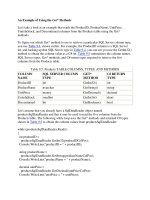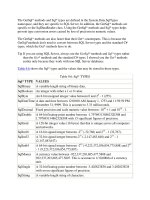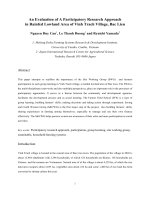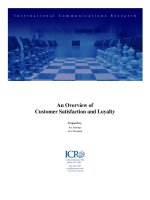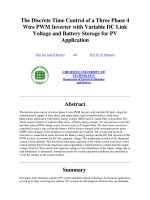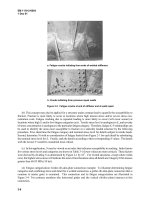Tài liệu An Evaluation of A Participatory Research Approach in Rainfed Lowland Area of Vinh Trach Village, B pptx
Bạn đang xem bản rút gọn của tài liệu. Xem và tải ngay bản đầy đủ của tài liệu tại đây (247.77 KB, 8 trang )
An Evaluation of A Participatory Research Approach
in Rainfed Lowland Area of Vinh Trach Village, Bac Lieu
Nguyen Duy Can
1
, Le Thanh Duong
1
and Ryuichi Yamada
2
1: Mekong Delta Farming Systems Research & Development Institute,
University of Cantho, Cantho, Vietnam
2: Japan International Research Center for Agricultural Science
Tsukuba, Ibaraki 305-8686 Japan
Abstract
This paper attempts to reaffirm the importance of the Site Working Group (SWG) and farmers
participation in such group learning in Vinh Trach village, a rainfed lowland area of Bac Lieu. The SWG is
the multi-disciplinary team-work and also multiple perspectives, plays an important role in the processes of
participatory approaches. It serves as a liaison between the community and development agencies,
facilitates the development process and as social learning. The Farmer Field School (FFS) is a type of
group learning, building farmers’ skills, making decisions and taking action through experiment. Saving
and Credit Women Group (S&CWG) is the first major step of the project, also building farmers’ skills,
sharing experiences in farming among themselves, especially to manage and use their own finance
effectively. The S&CWG helps poorers women are awareness of their roles and more participation in social
activities.
Key words:
Participatory research approach, participation, group learning, site working group,
sustainable, household farming systems
Introduction
Vinh Trach village is located in the coastal area of Bac Lieu town. The population of the village in 2003 is
about 13,964 inhabitants with 2,396 households, of which 525 households are Khmer, 156 households are
Chinese and the remains are Vietnamese. Natural area of of the village is about 4,229 ha, of which the rice
land area occupies about 2,855 ha, vegetables area about 232 ha and some 1,400 ha of rice land has been
converted to shrimp culture this year.
1
Most of the agricultural land of the village belongs to rainfed lowland and extremely influenced by
saline water intrusion in the dry season. Rice farming is a major production activity but low yield and low
income. Keeping small animals, culturing fish/shrimp and growing other crops have paid more attention by
farmers to get more income. From 1996 to 1998 the Farmer-Centred Agricultural Resource Management
(FARM) Program as its mission supports improved sustainable agricultural resource management and the
attainment of household food security through innovative approaches. The objective of the FARM Program
is to enhance the capabilities of GOs and NGOs, to build local capacity of resource poor farmers for
sustainable use and management of agricultural and natural resources to increase production and incomes
in the coastal rainfed areas. However, the FARM Programme was soon stopped and farmers still facing
with many problems such as lack of knowledge of growing new crops and animals, pests and diseases on
new crops, lack of capital and low price of agricultural products, etc. Under such circumstances, the
JIRCAS Project has continued to promote a participatory research approaches to support the small-scale
household farming in utilizing and managing of agricultural and natural resources reasonably. Central
elements in this participatory research are team-work (based on site working group), focussed collection of
information, group learning and women saving and credit activities.
This paper attempts to reaffirm the importance of farmers participation in such group learning.
Using the detailed case studies from Vinh Trach village, it demonstrates that the type of SWG and farmers
have the desire and ability to solve their own problems when give the opportunity to do.
Building The Site Working Group
A Site Working Group (SWG) was formed at the field site on November 2000. The SWG consists of 8
members, representing of different local organizations: two members from Farmer Association; two
members from Women Union at village level; two technicians specialization from Agricultural Extension
Center and Agricultural & Rural Development Session of district level; one from Cantho University; and
the team leader from Village People Committee, who to take charge of agricultural sector. The core
function of the SWG is to manage the project activities, prepare research plans and implement field works.
In general, the SWG acts to bring a collaborative, multi-sector and multi-disciplinary approach, opening up
space for farmers participation, gender equity and decision making at the village level.
SWG Serves as A Liaison between The Community and Development agencies,
as well as An Initial Motivator of The Community
Most of members of SWG are leaders or they play an important role in their own organizations. When
development agencies arrive in the village, they often contact with these leaders. These leaders can
2
organize or call together the community for meetings or classes, and help explain the purpose of new
prorams or government policies to the other villagers.
Some members of SWG are also often the first people to try out new technologies in small plots in
their fields. These try out plots are the factor responsible for stimulating the interest of other farmers.
SWG Facilitates The Development Process, as well as That of Sustainable
Farming systems
In general SWG has special advantages in facilitating the development process. SWG members as they are
most important people in the community, they often bring ideas, new technologies to share with their own
organizations and communities. SWG can serve as communicators of information from more technical,
nationalwide sources and make it understandable to farmers in the village.
Through the activities of the project, SWG has helped farmers in development of household farming
system. For instance, they introduce integrated rice – upland crop, VAC (Vuon-Ao-Chuong) and VACB
(Vuon-Ao-Chuong-Biogas) systems to farmers. Several farmers have practiced these systems successfully
and farmers incomes improved.
SWG as Social Learning, Organizing Ourselves for Innovation More Effectively
The SWG is the multi-disciplinary team-work and also multiple perspectives. It gives the appreciative
character of social organization of innovation. In fact that SWG acts to bring a collaborative and linking
among important actors. In operation, when the project started, a workshop on research priorities was
conducted on July 2000. During the process of the field site activities, the Participatory Assessment and
Planning (PAP) and Participatory Monitoring & Evaluation (PME) were the major tools to be used for
community and household intervention for making plans, setting priorities and evaluating innovations in
order to improve household farming and its incomes. By those participatory approaches, the SWG, farmers
and communities have identified a number of major problems and tried to solve them (Box 1).
Farmer Field School (FFS)
3
FFS as a participatory method for group learning for innovation more effectively. Two FFSs (the first on
rice production and second on safety cucumber production) were conducted in the research site from May
to August 2001. Number of participants of each FFS was 24. Participants were divided into 4 groups with
6 participants per each group. Learning by doing as an effectively method performed for these schools. In
many ways, an action research facility was developed in a FFS to help farmers to understand their
ecological farming. Regular meetings of class were held, farmers went to the field to make observations,
gathering data and processing data. The role of SWG is to facilitate the whole process, they were not only
to plan but to help farmers in experiment design and implementation. Through these FFSs, skills are built
for making decisions and taking action based on an open discussion of ideas. These decisions form the
basis for hypotheses which are tested in the farmer field. Enhancing farmers’s capacities are involved in the
processes of school activities (practising, observations and analysis processes). When farmers completed
their FFS, they are able to take decisions about actions which will improve their situation. The skills learnt
in FFS activities helped them become more confident about carrying out field experiment and solving
problems by themselves. Experinces learnt from FFS in the village are summarized in Box 2.
One of the follow-up activities of FFSs, and other trainings is the development of action plan, which
SWG members help participants to develop and implement on their own field, and of course participants
are able to take decisions about their actions. After two years of the project cycle, the team has evaluated
these activities. In general, farmers has applied knowledges what they learnt from FFSs and trainings to
improve their farming. For instance, farmers used IPM as the way to manage of pests and diseases on rice;
used of leaf color chart (LCC) technique to apply fertilizer on rice; growing cash crop after harvesting rice,
especially using plastic sheet technique; and application of VAC systems (Table 1).
4
eBox 1. Identification of problems and research options:
Major problems identified during the Workshop on research priorities on July 2000 are:
1. For mono-rice systems: Rice producers are dependent on rainfall, shortage of capital, and are
facing with pests, diseases and weeds problems as well as low price of outputs.
2. For rice –upland crop systems: Farmers are facing with serious problem of pests and diseases o
n
crops, lack of technical knowledge in upland crops growing, lack of capital to build deep-well,
unstable and low price of products.
3. For farmers practiced with VAC systems: Lack of capital to invest for pig pen, piglet, high price
of feeds, diseases on animal, and unstable and low price of products are major problems.
4. For rice – shrimp systems: Rice is damaged by insects and diseases, water from river polluted b
y
chemicals, lack of technical knowledge in shrimp growing, low price of rice and shrimp.
Research options and priority
1. Establishment of saving and credit together with technologies guidance.
2. Selection of new rice varieties with high yield, resistant to pests and diseases, and good quality
is proposed.
3. Application of IPM on rice and on upland crops growing. Using of “agricultural cover sheet” fo
r
growing upland crops
4. Development of rice-shrimp system.
5. Selection of suitable and valuable upland crops, fruit trees and animals.
6. Study on socio-economic of VAC-systems. f
5
eBox 2. Experiences learnt from FFS in Bac Lieu:
- Learners/Farmers are centered approach
- Effective adult learning requires, learning is relevance to needs of participants
- Number of participants limited (24 participants)
- All major stages in life cycle of crops are covered
- The field is a classroom
- Opportunity to practice in real situation
- Study fields focusing on local issues
- Participatory and experiential methodology
- Group dynamics
- Field day
- Monitoring and evaluating during FFS period
- Follow-up planning f
Table 1. Farmers participated in the project activities and followed-up.
Describe of activities Number of farmers
participated
Number of
time
% farmers
adopted
FFS on rice production, application of
IPM and LCC on rice
24 1 100
FFS on cucumber production,
application of IPM and use of plastic
sheet technique
24 1 40
Training on rice-shrimp system 50 4 30
Study visit 15 1 27
Training on small livestock production,
application of VAC systems
35 1 39
Source: Site Working Group of Baclieu, 2002.
Saving and Credit Women Group
The Saving and Credit Women Group (S&CWG) was formed by FARM/FAO project and it was
considered to be a method to improve the gender equity, and to allow women participation in the
development of sustainable agriculture (N.D. Can, 2000). In 2001 when JIRCAS project arrived at the
village, gender has identified to be an important factor that supports small-scale household farming for
sustainable use and management of agricultural resources. The SWG has seclected 20 women members
from 3 S&CWGs in the village. At the first year there were 10 members received loan with an amount of
2,000,000 VND per each. Other members will receive loan after then with the agreement of their own
groups. Before receiving loan, the SWG together with farmers identified their own problems, possible
solutions and helped them to prepare for their own action plan. Through these S&CWGs activities, regalar
6
meetings were held monthly, farmers made saving and sharing skills and experiences in farming among
themselves, especially to manage and use their own finance effectively.
Besides learning more about women farming activities, an important impact of the S&CWG is
empowerment of the poor. Poorers women are awareness of their roles and more participation in social
activities. There is an evolution in the quantity of S&CWG in the village. There was only 3 S&CWGs in
year 2000, that become 11 groups in 2001 and increased up to 16 groups in 2002-2003 with about 300
womem paticipation.
Box 3 showed the livelihoods outcomes after three years of the project cycle as women received
small loan from project for improving their farming.
eBox 3. Livelihoods outcomes
F
arming activities:
- Farmers have diversified their farming: integrated crop-animal, rice-upland crop, rice-
shrimp, VAC systems, VACB systems
- Number of livestock raising increased
- More intensive in farming practices and sustainable use of household resources
F
armer’s aware/knowledge:
- Active participation of farmers problem definition, analysis and problem solving (FFSs)
- Farmers have more opportunities for exchange skills/experiences in farming among them
- Farmers have more experiences/ skills in growing new rice varieties (pest & disease
control); more experiences/ skills in growing cucumber (using plastic sheet)
H
ousehold income:
- Source of incomes is more diversity: rice, other crops and animals keeping
- Farmers incomes per year improved ( 8- 15 million VND/year/per household) f
Conclusions
Using the detailed case studies from Vinh Trach village of Bac Lieu, it demonstrates that farmers can
manage in solving problems to improve their household farming systems when given the opportunity to do
so. It helps us to see the farmers as the principle actors among other relevant actors in the processes of
participatory approaches.
7
Literature Cited
Nguyen Duy Can, Le Thanh Duong and Ryuichi Yamada, 2002. A Participatory Research Approach
Supporting Small-Scale Household Farming Development in Rainfed Lowland in Bac Lieu. In:
Proceedings of the 2002 annual workshop of JIRCAS Mekong Delta Project. November 26-28,
2002. College of Agriculture, Cantho University, Cantho, Vietnam, p 382-387.
Nguyen Duy Can, 2000. The approaches for sustainable agricultural resources management: Lesson from
Bac Lieu field site. A report to JIRCAS project (un-publishing).
JIRCAS, 1997. A diagnosis of the rainfed farming systems in coastal area in Bac Lieu: A PRA study. (A
scientific report to JIRCAS project).
Tóm lược
Đánh giá về cách tiếp cận nghiên cứu có sự tham gia ở vùng nước trời xã Vĩnh Trạch, Bạc Liêu
Nguyễn Duy Cần
1
, Lê Thành Đương
1
và Ryuichi Yamada
2
(
1
Viện Nghiên Cứu và Phát Tiển Hệ Thống
Canh tác,Đại Học Cần Thơ, Cần Thơ, Việt nam,
2
Japan International Research Center for Agricultural
Science,Tsukuba, Ibaraki 305-8686 Japan)
Bài bcáo cáo nầy nhằm một lần nữa xác nhận tầm quan trọng của Nhóm Công Tác Điểm (SWG) và sự
tham gia của nông dân trong loại hình nhóm học tập ở xã Vĩnh Trạch, vùng nước trời của Bạc Liêu. Nhóm
SWG là nhóm công tác đa ngành, và đa quan điểm, có vai trò quan trọng trong các tiến trình của cách tiếp
cận có sự tham gia. Nó như là sự đại diện giữa cộng đồng và các cơ quan phát triển, điều hành và tạo sự dễ
dàng của tiến trình phát triển và nhóm học tập. Lớp học trên đồng ruộng nông dân (FFS) là một loại hình
của nhóm học tập, xây dựng kỹ năng, đưa ra quyết định and hành động thông qua thí nghiệm. Nhóm phụ
nữ tiết kiệm và tín dụng là bước chủ yếu đầu tiên của dự án, cũng xây dựng kỹ năng cho nông dân, chia sẻ
kinh nghiệm về sản xuất giữa chính họ, đặc biệt quản lý và sử dụng tiền vốn một cách có hiệu quả. Nhóm
phụ nữ tiết kiệm và tín dụng giúp những phụ nữ nghèo nhận thức được vai trò của họ và tham gia gia vào
các hoạt động xã hội nhiều hon.
8

